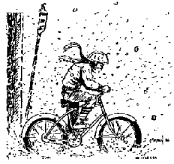WINTER RIDING
| 
|
Riding a bicycle during the winter months in New England can be done!
It will not always be pleasant, but it can be fabulous. No impossible
efforts or improbable skills are required. Here are some suggestions
on how to get from here to there in snow.
RIDING IN THE WINTER: GETTING STARTED
There are a lot of reasons why riding in the winter is not as crazy as
it sounds. With the advent of All Terrain Bikes it is even easy, but
you don't need a Mountain Bike to ride during the winter. With a certain
amount of common sense and some minor modifications to your trusty
two-wheeler you can keep riding year-round.
WHAT YOU'LL NEED: FOR YOURSELF
Pedalling around in the winter can be a cold and wet experience. You
need to prepare yourself for conditions which will not be comfortable.
Dress in layers:
- Long underwear made of a material that will wick sweat away from
your body. This is important because sweat chills the body. You don't
want that!
- Layers above this as necessary to keep warm. How many layers you'll
need is up to you.
- A windbreaker or rain suit over everything else. Wear something that
will keep water from getting in, but allow sweat vapor to escape.
Wear a helmet:
- Add a helmet liner or ski mask under the helmet. You'll stay warmer
because your head loses the most heat.
- Tape over the vent holes in your helmet to cut heat loss even more.
Make yourself visible:
- Use leg lights, a reflective vest, or other visibility boosters in
addition to your regular lights and reflectors. There's less daylight
during the winter.
Exercise caution:
- If you suspect conditions may be worse than you can handle, use
another way to get around.
WHAT YOU'LL NEED: FOR YOUR BIKE
Winter can be as tough on your bike as it is on you. You'll want to make
some modifications when the snow and ice begin to fly.
Fenders and mudflaps:
- Fenders will keep mud and slush off of you, and your feet will stay
dryer. A mudflap on the front wheel will keep goop off your frame, chain
and derailleur.
Fat tires and aluminum rims:
- Fat tires handle better than skinny ones; aluminum rims provide
better braking in wet weather than steel rims do.
A good lighting system:
- Reflectors do not work when you need them most! You need head and tail
lights, at a minimum.
A rear-view mirror:
- You'll need to concentrate on the snow and ice in front of you. Use
a rear-view mirror as well as turning your head to look for traffic.
A clean bike:
- Clean and lubricate your chain frequently! It will pick up a lot of
sand when you ride. If you keep your bike indoors, clean it off frequently:
it will rust faster indoors than it will if you keep it outdoors.
GETTING OUT THERE: RIDING IN THE SNOW
The roads are less safe, and there is less light in the winter. Ride defensively!
Ride slowly and cautiously:
- Take a lane if necessary.
- Watch out for ice patches. If you hit an ice patch, don't use your
front brake: you can skid and fall.
- Allow at least 3 times the normal braking distance to stop.
- Sprint with traffic in the ruts made by cars if you can: cars do a
great job of clearing paths for winter cyclists.
- Use your rear brakes only.
- Ride on less-travelled streets whenever possible.
- Be careful out there!
ONLINE RESOURCES
- ICEBIKE,
Home of the Winter Cyclist
- A lot of information, including unfiltered recommendations on how to deal
with winter bicycling from many contributors, an e-mail list and a winter
cycling photo contest.
-
Winter Cycling Web Page
- Tips and equipment for winter cycling from All Weather Sports in
Fairbanks, Alaska.
- Massachusetts Bikepath Plowing Report
- MassPaths' report is updated after (and sometimes during)
every major snowfall.
- Harvard Gazette winter 2004 article
- Doug Mink's take on winter biking, with a cool picture.

